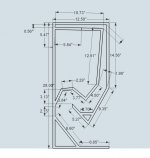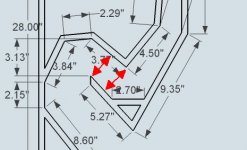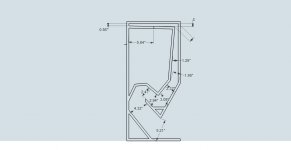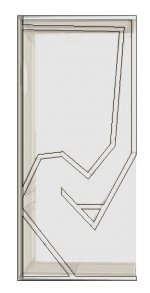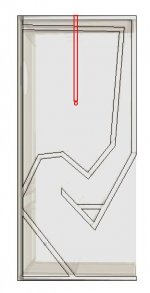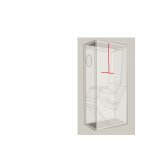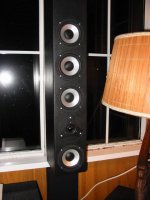What I need is a little more guidance to make this drawing. In other words, do I go by the sketch itself or the dimensions? The reason I went with the sketch itself is there doesn't seem to be enough dimensions to construct a drawing.
Tomlang,
Use the drawing in post #58 : http://www.diyaudio.com/forums/attachments/full-range/347289d1367939164-decware-dna-horn-dna-plan-rescaled.pdf
I messed up on the first drawing when I converted the 3dim perspective to 2d in only 1 dim. It ended up lengthening it to about 20% too tall. The new drawing has aspect ratio corrected. There are two known dimensions shown and you can work out the rest using scale in CAD program or a ruler.
Regards,
X
Here is the latest tracing it full size. Before I go any further, let me know if any dimensions need to be changed. This is using 1/2 inch material.
I'm seriously considering making one of these using 3/4 material (yes, I know I have to account for that). However, I want to use the MCM Part # 55-1870 but shows backordered till August!
I'm seriously considering making one of these using 3/4 material (yes, I know I have to account for that). However, I want to use the MCM Part # 55-1870 but shows backordered till August!
Attachments
What does your CAD program read through this section. Is there a pinch?
Also, I started this yesterday but didn't complete. Since you have the linear dims (one long straight line), can you lay out the widths at segment points with vertical lines to get a picture of the expansion. Would be fun to see.
Also, I started this yesterday but didn't complete. Since you have the linear dims (one long straight line), can you lay out the widths at segment points with vertical lines to get a picture of the expansion. Would be fun to see.
Attachments
Last edited:
Tomlang,
Very nice CAD drawing - thanks for doing that for us. Looks like you are doing this is Solidworks based on the the appearance. Nice CAD program - I use that myself when I want to model something in 3d.
I agree with Bob that visually it looks like the horn actually contracts here. But that may be intended by the designer. What we did was to rotate the lip piece CCW a few degrees until the channel on both sides was expanding. Otherwise it looks good. If you want mcm 1870 driver you need to reduce driver chamber volume to about 5/8 of what it is originally. Either by putting walls inside to make volume smaller or adding blocks of stuff to take up volume.
Good luck!
Very nice CAD drawing - thanks for doing that for us. Looks like you are doing this is Solidworks based on the the appearance. Nice CAD program - I use that myself when I want to model something in 3d.
I agree with Bob that visually it looks like the horn actually contracts here. But that may be intended by the designer. What we did was to rotate the lip piece CCW a few degrees until the channel on both sides was expanding. Otherwise it looks good. If you want mcm 1870 driver you need to reduce driver chamber volume to about 5/8 of what it is originally. Either by putting walls inside to make volume smaller or adding blocks of stuff to take up volume.
Good luck!
It definitely pinches per the first drawing.
I also traced a near side view from this page, that is the 2nd drawing. Scroll down till you see the 4 views. It is slightly different, still a pinch though.
Decware's Single Driver Horn
1. What picture did you initially scale from?
2. I read earlier but am confused what to change to use two of the really cheap Madisound drivers in one enclosure.
3. How about these?
5 Inch 20W 8 Ohm Full Range Dual Cone Speaker | XF-131-828 (XF131828) | Distributed By MCM
5 Inch 50W 8 Ohm Full Range Dual Cone Speaker | SP-50X (SP50X) | Distributed By MCM
I also traced a near side view from this page, that is the 2nd drawing. Scroll down till you see the 4 views. It is slightly different, still a pinch though.
Decware's Single Driver Horn
1. What picture did you initially scale from?
2. I read earlier but am confused what to change to use two of the really cheap Madisound drivers in one enclosure.
3. How about these?
5 Inch 20W 8 Ohm Full Range Dual Cone Speaker | XF-131-828 (XF131828) | Distributed By MCM
5 Inch 50W 8 Ohm Full Range Dual Cone Speaker | SP-50X (SP50X) | Distributed By MCM
Attachments
Unless you are building with wood, my trial indicates two drivers will create massive fluctuation in the top half, both sides and top. The same may result from using a driver with a larger/stronger magnet. If you use FC try to find something with high density (small bubble size). A couple strips or a plate of thin plywood on the outside - tied together with wood dowels - might help.
Attachments
Last edited:
I scaled the drawing from the first picture in this link. The DECWARE DNA Horn
I will have to model those drivers to see how it works. A possibility is to use two of the MCM 55-1870 instead of reducing the chamber volume. I will have to run model.
I will have to model those drivers to see how it works. A possibility is to use two of the MCM 55-1870 instead of reducing the chamber volume. I will have to run model.
The fully measured drawings are available from Steve for $20 (some folks have already purchased them, even if just for research purposes  ), and should save all the guessing.
), and should save all the guessing.
As Zobsky pointed out several pages back, with an over .5ft^3 driver chamber, this is really more of a hybrid BVR with a long folded vent than a "true" BLH (whatever that is ), and as always, it's the results that really matter.
), and as always, it's the results that really matter.
It's not at all unusual for designs of this type to include a "pinch" in the expansion flare near the mouth, the FH3 certainly does.
I'd forgotten about Steve's design white paper from a couple of years ago, in which he lists several driver candidates, including the usual suspects from Fostex for small BLH enclosures, - FE103, FE108Z, FE126. F120A & FX120, as well as a Fountek and the now discontinued W5 1880.
As Zobsky pointed out several pages back, with an over .5ft^3 driver chamber, this is really more of a hybrid BVR with a long folded vent than a "true" BLH (whatever that is
It's not at all unusual for designs of this type to include a "pinch" in the expansion flare near the mouth, the FH3 certainly does.
I'd forgotten about Steve's design white paper from a couple of years ago, in which he lists several driver candidates, including the usual suspects from Fostex for small BLH enclosures, - FE103, FE108Z, FE126. F120A & FX120, as well as a Fountek and the now discontinued W5 1880.
Due to cheap costs involved, I have ordered the plans and Aura drivers. Can anyone suggest a tweeter that I could build? Similar to this http://www.diyaudio.com/forums/full-range/192083-frugal-super-tweeter.html
Thanks all ��
Thanks all ��
For anyone wondering about the MCM 55-1870 drivers, there is a dual driver plus tweeter combo here that confirms my suspicion that these are nice: Single Driver Website
I am going to see if the DNA can possibly accommodate two of the 1870's in the sim.
I am going to see if the DNA can possibly accommodate two of the 1870's in the sim.
All this talk about the 55-1870 and I remember why that # sounded familiar. I use them in the sunroom HT for the L&R channels. 
I am partly on board with GM in that I find they are not as good as they look but the problem I have is, I have to pump a lot of juice into them to wake them up so I converted their use to strictly HT - no music. I don't use them for the center channel either, vocals are too recessed.
I am partly on board with GM in that I find they are not as good as they look but the problem I have is, I have to pump a lot of juice into them to wake them up so I converted their use to strictly HT - no music. I don't use them for the center channel either, vocals are too recessed.
Attachments
You mean shouty at high levels? Possibly something to do with the aluminum cone maybe... Paper is always smoother.
Yeah, though even at fractional power unless XO'd really low: Single Driver Website
GM
I got them from someone who thought they might use them for a small scale production, 2 way system. Apparently that didn't work out. He sold them to me for 5 buck a pop, NIB so I bought 8. They seem a little light on the bass, recessed mids and...well what else do you want them for? No, I wouldn't recommend them, even if my findings differ from GM's, we agree they are probably better on a shelf. One thing I always agree on with GM though is YMMV. 
Hmm, IIRC this is the driver used in the original LINUS Array. If so, then it sounds fine at very low power, but it's one nasty sounding 'squawker' otherwise.
FWIW, as I understand it, Doc Bottlehead was partly responsible for this unit. If memory serves, they stopped using it when the company manufacturing the thing made changes which royally fouled it up compared to the original / what it was supposed to be -the curvilinear cone went west, & I think some changes were made to the suspension too, presumably to get manufacturing costs lower. So possibly the earlier versions were OK, but the later drivers ended up being 'cheap & nasty' rather than 'decent for the money.' I suspect even in original form it needed to be used in multiples to get decent performance, so I probably don't want to know what the later units sound like with a few watts up their terminals.
Yeah, though even at fractional power unless XO'd really low: Single Driver Website
I'm thinking LR4 at ~1.5KHz with a couple of notches in the stopband.
You mean shouty at high levels? Possibly something to do with the aluminum cone maybe... Paper is always smoother.
Not so. It can be and often is, but the inherent response / behaviour of a drive unit is a whole lot more complicated than that. It depends on the specific properties of the materials in question (i.e. what metals / paper mix are employed), the cone profile and thickness[es], suspension, coil, motor design &c., to say nothing of the design objectives and how they're used. We can all think of drive units with paper cones for e.g. that would take your head off, so it's not a hard and fast rule.
Last edited:
FWIW, as I understand it, Doc Bottlehead was partly responsible for this unit.
I'm thinking LR4 at ~1.5KHz with a couple of notches in the stopband.
We can all think of drive units with paper cones for e.g. that would take your head off, so it's not a hard and fast rule.
Ah! Couldn't remember where I'd seen it first and Paul's last XO is probably a good starting point: Straight 8
Yeah, inherently, aluminum is superior to paper for tonally correct wide BW driver designs, but it's just too expensive/labor intensive and ideally needs to be limited to tiny excursions like in a compression driver. Ditto beryllium and then there's man made composites.......
The beauty of paper is it's so cheap/easy to tweak to 'taste', but to date, the best performing overall I've auditioned are thin foil laminated paper units, so if I had the patience/desire to design or at least 'customize' a 'FR' driver these days...........
GM
- Home
- Loudspeakers
- Full Range
- Decware DNA Horn
